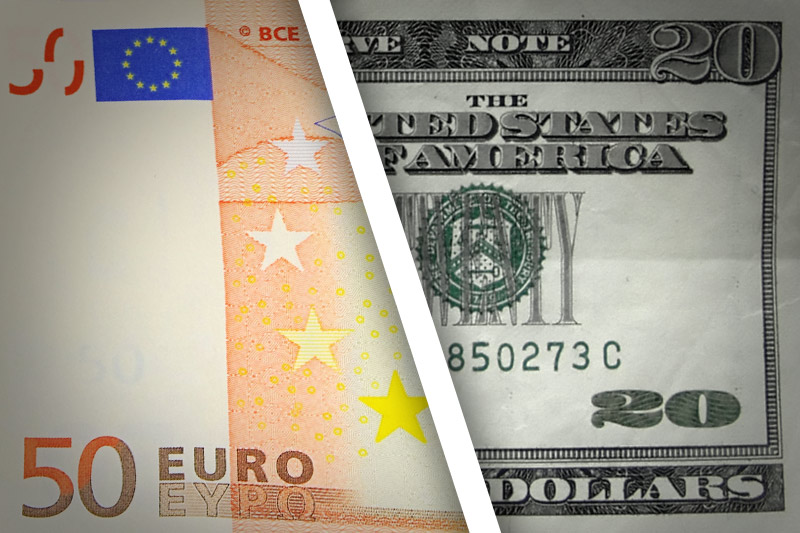Investing.com - The euro extended losses against the U.S. dollar on Thursday, falling to a fresh one-week low as a string of mostly disappointing manufacturing and service sector activity data from the euro zone dented demand for the single currency.
EUR/USD hit 1.2931 during European afternoon trade, the pair's lowest since September 13; the pair subsequently consolidated at 1.2945, dropping 0.8%.
The pair was likely to find support at 1.2853, the low of September 13 and resistance at 1.3058, the daily high.
Sentiment on the euro remained vulnerable after data showed that euro zone manufacturing activity improved modestly in September, but remained in contraction territory for the 13th consecutive month, while service sector activity slumped to the lowest level since July 2009.
The euro zone’s manufacturing purchasing managers’ index rose to a seasonally adjusted 46.0 in September from a final reading of 45.1 in August, compared to expectations for a reading of 44.5.
The services PMI fell to 46.0 from 47.2 in August. Analysts had expected the index to tick up to 47.4 in September.
Manufacturing activity in France tumbled unexpectedly in September, dropping to a three-and-a-half year low.
France’s manufacturing PMI fell to 42.6 in September from a final reading of 46.0 in September. Analysts had expected the index to come in at 46.4.
Service sector activity in France declined to a four-month low of 46.1 in September from a final reading of 49.2 in August.
The euro found brief support earlier after data showed manufacturing activity in Germany in September contracted at the slowest rate in six months, while service sector activity grew modestly.
Germany’s manufacturing PMI rose to 47.3 in September from a final reading of 44.7 in September. Analysts had expected the index to come in at 45.3.
Service sector activity in Germany increased to a four-month high of 50.6 in September from a final reading of 48.3 in August.
The data came after a report showed China’s HSBC flash purchasing managers' index ticked up to 47.8 in September from a nine-month low in August of 47.6, but remained below 50 for an 11th consecutive month in a row, showing the sector was still contracting.
Also Thursday, Spain saw borrowing costs fall at an auction of ten-year government bonds on Thursday, amid ongoing uncertainty over whether Spain is about to ask for more financial aid, which would mean signing up to a permanent bailout fund.
Spain’s Treasury sold EUR859 billion worth of 10-year government bonds at an average yield of 5.66%, down from 6.64% at a similar auction last month.
Elsewhere, the euro was also lower against the pound with EUR/GBP shedding 0.61%, to hit 0.7995.
Later in the day, the U.S. was to release its weekly government report on initial jobless claims, as well as an index of manufacturing activity in Philadelphia.
EUR/USD hit 1.2931 during European afternoon trade, the pair's lowest since September 13; the pair subsequently consolidated at 1.2945, dropping 0.8%.
The pair was likely to find support at 1.2853, the low of September 13 and resistance at 1.3058, the daily high.
Sentiment on the euro remained vulnerable after data showed that euro zone manufacturing activity improved modestly in September, but remained in contraction territory for the 13th consecutive month, while service sector activity slumped to the lowest level since July 2009.
The euro zone’s manufacturing purchasing managers’ index rose to a seasonally adjusted 46.0 in September from a final reading of 45.1 in August, compared to expectations for a reading of 44.5.
The services PMI fell to 46.0 from 47.2 in August. Analysts had expected the index to tick up to 47.4 in September.
Manufacturing activity in France tumbled unexpectedly in September, dropping to a three-and-a-half year low.
France’s manufacturing PMI fell to 42.6 in September from a final reading of 46.0 in September. Analysts had expected the index to come in at 46.4.
Service sector activity in France declined to a four-month low of 46.1 in September from a final reading of 49.2 in August.
The euro found brief support earlier after data showed manufacturing activity in Germany in September contracted at the slowest rate in six months, while service sector activity grew modestly.
Germany’s manufacturing PMI rose to 47.3 in September from a final reading of 44.7 in September. Analysts had expected the index to come in at 45.3.
Service sector activity in Germany increased to a four-month high of 50.6 in September from a final reading of 48.3 in August.
The data came after a report showed China’s HSBC flash purchasing managers' index ticked up to 47.8 in September from a nine-month low in August of 47.6, but remained below 50 for an 11th consecutive month in a row, showing the sector was still contracting.
Also Thursday, Spain saw borrowing costs fall at an auction of ten-year government bonds on Thursday, amid ongoing uncertainty over whether Spain is about to ask for more financial aid, which would mean signing up to a permanent bailout fund.
Spain’s Treasury sold EUR859 billion worth of 10-year government bonds at an average yield of 5.66%, down from 6.64% at a similar auction last month.
Elsewhere, the euro was also lower against the pound with EUR/GBP shedding 0.61%, to hit 0.7995.
Later in the day, the U.S. was to release its weekly government report on initial jobless claims, as well as an index of manufacturing activity in Philadelphia.
